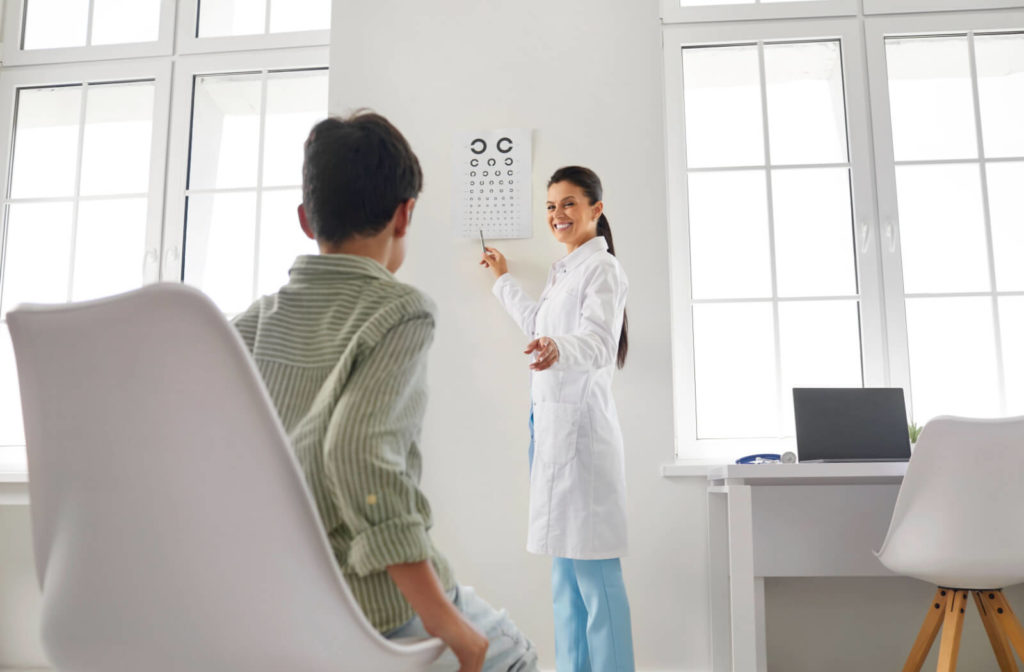Your vision is a complex system that involves the brain and the eyes working together. But did you know that healthy eyesight is not just about seeing clearly?
Nurturing other skills to strengthen your eyes and visual systems is also important.
Vision therapy can help develop visual skills using various eye exercises and tools.
What Are Visual Skills?
Visual skills refer to the abilities and competencies that allow us to interpret, understand, and navigate the visual world around us. These skills encompass a range of capabilities needed to succeed in learning, reading, sports, and life.
17 vital visual skills go beyond mere visual acuity, including the following:
- Eye movement control: Moving both eyes together on the same target or along the same path, like reading a line of text.
- Near and distance focusing power: Forming and keeping a clear image close-up or at a distance.
- Eye alignment at the same point: Lining up both eyes and holding them lined up close or at a distance.
- Depth perception: The ability to discern how far or close things are to each other.
- Color perception: The ability to differentiate between colors.
- Visual perception: Awareness of your environment and visual field.
- Visual integration: Using your vision and other senses to accomplish complex tasks.
How Can Vision Therapy Help?
Vision therapy is a specialized program for improving and enhancing various visual skills and abilities. It’s a non-invasive approach that can address poor eye coordination, focusing difficulties and visual perceptual problems.
Your eye doctor may use devices and tools such as therapeutic lenses, prisms, patches, balance boards, and colored filters to achieve this. Vision therapy uses a personalized approach for individual needs to guide patients through a structured program that promotes better visual functioning, leading to improved quality of life and greater ease in daily visual tasks.
How Does Vision Therapy Work?
Unlike glasses, contact lenses, or eye surgery that compensates for vision problems, vision therapy teaches and retrains the visual system to correct vision problems. Neuroplasticity is the brain’s ability to change structure and function in response to external stimuli.
Vision therapy can cause neurological changes between the brain and the eye, your visual system, to correct vision problems and improve visual performance. Retraining the brain and eyes to work together more efficiently can include combining therapeutic exercises, activities, and other techniques.
Who Is Vision Therapy For?
Vision therapy can benefit individuals of all ages. 1 in 10 children have a vision problem that impacts their learning. These learning-related vision problems can affect their performance in school and sports.
Unfortunately, if not treated early, children with these vision problems often become adults with vision problems. The good news is that vision therapy isn’t only for children. Vision therapy can benefit and be effective for adults experiencing visual discomfort or difficulties without having to compensate for these problems.
What Conditions Can Vision Therapy Treat?
Vision therapy can address several visual conditions and challenges. Some of the conditions that can be treated or improved through vision therapy include:
- Strabismus (crossed eyes): Vision therapy can improve eye alignment and coordination for individuals with strabismus, helping both eyes to work together more effectively.
- Amblyopia (lazy eye): Vision therapy aims to strengthen the weaker eye in cases of amblyopia, helping improve visual acuity and depth perception.
- Binocular vision dysfunction: Conditions like convergence insufficiency, where the eyes struggle to work together to focus on close objects, can be managed through vision therapy.
- Focusing problems: Vision therapy can help individuals improve their ability to shift focus between near and distant objects, reducing eye strain and discomfort.
- Visual processing disorders: Issues with visual perception, such as difficulties recognizing shapes, letters, or numbers, can be targeted through vision therapy to improve overall visual processing skills.
- Sports vision enhancement: Athletes can improve their visual skills, including hand-eye coordination, depth perception, and peripheral awareness, through specialized vision therapy programs.
- Reading and learning challenges: Vision therapy can aid individuals with reading difficulties, improving their tracking skills, comprehension, and overall reading comfort.
- Stroke and brain injury recovery: For individuals recovering from stroke or traumatic brain injuries, vision therapy can help them regain visual skills.
Before beginning vision therapy, having a comprehensive adult or children’s eye examination helps to determine specific visual concerns and create a tailored treatment plan. It’s important to note that the effectiveness of vision therapy depends on the individual’s specific condition, their commitment to the therapy program, and the guidance of your optometrist.
Supporting Vision Skills at Any Age
Vision therapy is a safe, non-invasive, and effective treatment to help develop vital visual skills in adults and children to improve overall performance and quality of life.
For vision concerns, book an appointment with The Eye Gallery to discuss if vision therapy can address these and achieve your vision goals.




